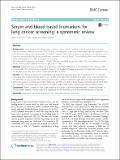Files in this item
Serum and blood based biomarkers for lung cancer screening : a systematic review
Item metadata
| dc.contributor.author | Chu, Gavin C. W. | |
| dc.contributor.author | Lazare, Kim | |
| dc.contributor.author | Sullivan, Frank | |
| dc.date.accessioned | 2018-02-14T10:30:07Z | |
| dc.date.available | 2018-02-14T10:30:07Z | |
| dc.date.issued | 2018-02-13 | |
| dc.identifier | 252130956 | |
| dc.identifier | d05db45b-e972-485a-b610-493089ab6358 | |
| dc.identifier | 85042070858 | |
| dc.identifier | 000425516500006 | |
| dc.identifier.citation | Chu , G C W , Lazare , K & Sullivan , F 2018 , ' Serum and blood based biomarkers for lung cancer screening : a systematic review ' , BMC Cancer , vol. 18 , 181 . https://doi.org/10.1186/s12885-018-4024-3 | en |
| dc.identifier.issn | 1471-2407 | |
| dc.identifier.uri | https://hdl.handle.net/10023/12719 | |
| dc.description.abstract | Background Lung cancer is the second most common cancer and the leading cause of cancer death for both men and women. Although low-dose CT (LDCT) is recommended for lung cancer screening in high-risk populations and may decrease lung cancer mortality, there is a need to improve the accuracy of lung cancer screening to decrease over-diagnosis and morbidity. Blood and serum-based biomarkers, including EarlyCDT-lung and microRNA based biomarkers, are promising adjuncts to LDCT in lung cancer screening. We evaluated the diagnostic performance of EarlyCDT-lung, micro-RNA signature classifier (MSC), and miR-test, and their impact on lung cancer-related mortality and all-cause mortality. Methods References were identified using searches of PubMed, EMBASE, and Ovid Medline® from January 2000 to November 2015. Phase three or greater studies in the English language evaluating the diagnostic performance of EarlyCDT-lung, MSC, and miR-test were selected for inclusion. Results Three phase 3 studies were identified, one evaluating EarlyCDT-lung, one evaluating miR-Test, and one evaluating MSC respectively. No phase 4 or 5 studies were identified. All three biomarker assays show promise for the detection of lung cancer. MSC shows promise when used in conjunction with LDCT for lung cancer detection, achieving a positive likelihood ratio of 18.6 if both LDCT and MSC are positive, and a negative likelihood ratio of 0.03 if both LDCT and MSC are negative. However, there is a paucity of high-quality studies that can guide clinical implementation. Conclusion There is currently no high quality evidence to support or guide the implementation of these biomarkers in clinical practice. Reports of further research at stages four and five for these, and other promising methods, is required. | |
| dc.format.extent | 6 | |
| dc.format.extent | 498378 | |
| dc.language.iso | eng | |
| dc.relation.ispartof | BMC Cancer | en |
| dc.subject | Lung cancer | en |
| dc.subject | Screening | en |
| dc.subject | Systematic review | en |
| dc.subject | Biomarkers | en |
| dc.subject | Primary health care | en |
| dc.subject | RC0254 Neoplasms. Tumors. Oncology (including Cancer) | en |
| dc.subject | SDG 3 - Good Health and Well-being | en |
| dc.subject.lcc | RC0254 | en |
| dc.title | Serum and blood based biomarkers for lung cancer screening : a systematic review | en |
| dc.type | Journal item | en |
| dc.contributor.institution | University of St Andrews. School of Medicine | en |
| dc.contributor.institution | University of St Andrews. Population and Behavioural Science Division | en |
| dc.identifier.doi | https://doi.org/10.1186/s12885-018-4024-3 | |
| dc.description.status | Peer reviewed | en |
This item appears in the following Collection(s)
Items in the St Andrews Research Repository are protected by copyright, with all rights reserved, unless otherwise indicated.

